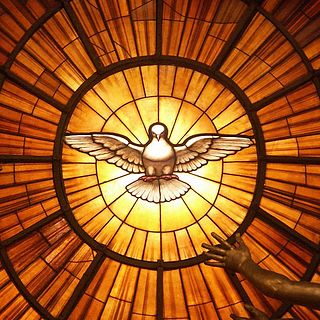Related Research Articles

Ecumenism – also called interdenominationalism, or ecumenicalism – is the concept and principle that Christians who belong to different Christian denominations should work together to develop closer relationships among their churches and promote Christian unity. The adjective ecumenical is thus applied to any non-denominational initiative that encourages greater cooperation and union among Christian denominations and churches.
A Christian denomination is a distinct religious body within Christianity that comprises all church congregations of the same kind, identifiable by traits such as a name, particular history, organization, leadership, theological doctrine, worship style and, sometimes, a founder. It is a secular and neutral term, generally used to denote any established Christian church. Unlike a cult or sect, a denomination is usually seen as part of the Christian religious mainstream. Most Christian denominations refer to themselves as churches, whereas some newer ones tend to interchangeably use the terms churches, assemblies, fellowships, etc. Divisions between one group and another are defined by authority and doctrine; issues such as the nature of Jesus, the authority of apostolic succession, biblical hermeneutics, theology, ecclesiology, eschatology, and papal primacy may separate one denomination from another. Groups of denominations—often sharing broadly similar beliefs, practices, and historical ties—are sometimes known as "branches of Christianity". These branches differ in many ways, especially through differences in practices and belief.

The International Pentecostal Holiness Church (IPHC) or simply Pentecostal Holiness Church (PHC) is an international Holiness-Pentecostal Christian denomination founded in 1911 with the merger of two older denominations. Historically centered in the Southeastern United States, particularly the Carolinas and Georgia, the Pentecostal Holiness Church now has an international presence. In 2000, the church reported a worldwide membership of over one million—over three million including affiliates.
The Confessing Movement is a largely lay-led theologically conservative Christian movement that opposes the influence of theological liberalism and theological progressivism currently within several mainline Protestant denominations and seeks to return them to its view of orthodox doctrine, or form a new denomination and disfellowship (excommunicate) them if the situation becomes untenable. Those who eventually deem dealing with theological liberalism and theological progressivism within their churches and denominations as not being tenable anymore would later join or start Confessional Churches and/or Evangelical Churches that continue with the traditions of their respective denominations and maintaining orthodox doctrine while being ecclesiastically separate from the Mainline Protestant denominations.
Church planting is a term referring to the process that results in a new local Christian congregation being established. It should be distinguished from church development, where a new service, worship center or fresh expression is created that is integrated into an already established congregation. For a local church to be planted, it must eventually have a separate life of its own and be able to function without its parent body, even if it continues to stay in relationship denominationally or through being part of a network.

The Apostolic Movement of Schoenstatt is a Catholic Marian movement founded in Germany in 1914 by Fr Joseph Kentenich, who saw the movement as a means of spiritual renewal for the Catholic Church. The movement is named after the small locality of Schönstatt which is part of the town of Vallendar near Koblenz, in Germany.

The Couples for Christ (CFC) is an international Catholic lay ecclesial movement whose goal is to renew and strengthen Christian values. It is one of 123 International Associations of the Faithful.

The Catholic Charismatic Renewal (CCR) is a movement within the Catholic Church that is part of the wider charismatic movement across historic Christian churches.
The Young Christian Workers is an international youth organization founded by the Catholic priest Joseph Cardijn in Belgium as the Young Trade Unionists. The organization adopted its present name in 1924.

The Neocatechumenal Way, also known as the Neocatechumenate, or NCW is an itinerary/process in the Catholic Church for faith formation. It is inspired by the catechumenate of the early Catholic Church where converts from paganism are able to be prepared for baptism through a process of faith formation. This post-baptismal formation helps deepen the faith for adults that have already been baptized, and provides basic instruction to those that are far from the Church. This itinerary of formation adapts the rites of the Rite of Christian Initiation of Adults (RCIA) for those that have already been baptized, without repeating the sacrament of baptism.
The Christian Life Movement is a lay ecclesial movement, founded in 1985, in Peru. At that time, a number of initiatives from members of the Sodalitium Christianae Vitae had already begun. Luis Fernando Figari, the Founder of the Sodalitium, conceived the idea of gathering those people and initiatives together in an ecclesiastic movement. The Christian Life Movement forms part of the Sodalit Family, which shares a common spirituality, called the Sodalit spirituality.

The Diocese of Gary is a Latin Church ecclesiastical territory, or diocese, of the Catholic Church in northwest Indiana in the United States. It is a suffragan diocese in the ecclesiastical province of the metropolitan Archdiocese of Indianapolis.

Michael James Nazir-Ali is a Pakistani-born British Roman Catholic priest and former Anglican bishop. He served as the 106th Bishop of Rochester from 1994 to 2009 and, before that, as Bishop of Raiwind in Pakistan. He is currently the director of the Oxford Centre for Training, Research, Advocacy and Dialogue. In 2021, he was received into the Catholic Church and was ordained as a priest for the Ordinariate of Our Lady of Walsingham on 30 October 2021, one of several Anglican bishops who converted to Catholicism that year. In 2022, he was made a monsignor. He is a dual citizen of Pakistan and Britain.
Religious adherents vary widely in their views on birth control. This can be true even between different branches of one faith, as in the case of Judaism and Christianity. Some religious believers find that their own opinions of the use of birth control differ from the beliefs espoused by the leaders of their faith, and many grapple with the ethical dilemma of what is conceived as "correct action" according to their faith, versus personal circumstance, reason, and choice. This article will discuss various views on birth control of the major world religions Christianity, Buddhism, Judaism, Islam, Hinduism, and Baha'i.
The Missionary Families of Christ (MFC), formerly known as Couples for Christ - Foundation for Family and Life (CFC-FFL) is a Philippine-based Catholic charismatic lay community that emphasizes individual renewal, family life renewal, Church renewal, societal renewal and evangelization. MFC is a missionary body, and the families and individuals that make up this association are to strive to be instruments of the Holy Spirit in renewing the face of the earth.

The Roman Catholic Archdiocese of Agra is a Latin Metropolitan archdiocese in northern India's Uttar Pradesh state. It comproses the following districts in Uttar Pradesh: Agra, Aligarh, Auraiya, Budaun, Bulandshahr, Etah, Etawah, Farrukabad, Firozabad, Gautambudha Nagar, Hathras, Kannauj, Mainpuri, Mathura and in Rajasthan: Bharatpur and Dholpur.
Characteristic of Christianity in the 19th century were evangelical revivals in some largely Protestant countries and later the effects of modern biblical scholarship on the churches. Liberal or modernist theology was one consequence of this. In Europe, the Roman Catholic Church strongly opposed liberalism and culture wars launched in Germany, Italy, Belgium and France. It strongly emphasized personal piety. In Europe there was a general move away from religious observance and belief in Christian teachings and a move towards secularism. In Protestantism, pietistic revivals were common.

Christianity is the largest religion practiced in Zimbabwe, accounted for more than 84% of the population. The arrival of Christianity dates back to the 16th century by Portuguese missionaries such as Fr. Gonsalo Da Silveira of the Roman Catholic Church. Christianity is embraced by the majority of the population. It is estimated 85 percent of Zimbabweans claim to be Christians, with approximately 62 percent regularly attending church services. Christian faith plays a very important role in the organization of Zimbabwean society.
References
- ↑ "Christian Family Movement, 2013. 15 February 2015". Archived from the original on 12 November 2008. Retrieved 24 November 2008.
- ↑ "Pozdol, Andy. Christian Family Movement. 24 NOV 2008. Christian Family Movement. 24 Nov 2008". Archived from the original on 12 November 2008. Retrieved 24 November 2008.
- ↑ Christian Family Movement website, FAQs
- 1 2 Encyclopedia.com website, Christian Family Movement
- 1 2 Archdiocese of Indianapolis website, Patty Crowley was most important lay woman of her time, article by John F. Fink dated March 30, 2018
- ↑ American Magazine website, Christian Family Movement 1960
- ↑ Bartleby website, The Christian Family Movement in the United States
- ↑ University of Notre Dame website, Archive section, Christian Family Movement Records, 1946-2016
- ↑ National Catholic Reporter website, Disturbing the Peace: A History of the Christian Family Movement, 1949-1974 by Jeffrey M. Burns, review by Robert McClory dated June 4, 1999
- ↑ "International Confederation of Christian Family Movements". Archived from the original on 2011-01-27. Retrieved 2013-07-05.
- ↑ "International Confederation of Christian Family Movements". Archived from the original on 2011-03-21. Retrieved 2013-07-05.
- ↑ Unsworth, Tim. "Millennium reunion of faded movement". National Catholic Reporter 37.3 (Nov 3, 2000): 18. Academic OneFile. Gale. 10 Nov. 2008
- ↑ McClory, Robert. "At 50, CFM is still alive and risking". National Catholic Reporter 34.n38 (Sept 4, 1998): 22(1). Academic OneFile. Gale. 10 Nov. 2008
- ↑ Christian Family Movement. Acting on Faith: The Acts of the Apostles and Today's Christian Families. 2012. p. 80.
- ↑ "Pozdol, Andy. Taking the Time to Make a Difference. 3 AUG 2012. Christian Family Movement. 3 AUG 2012". Archived from the original on 30 November 2012. Retrieved 3 August 2012.
- ↑ "Pozdol, Andy. Christian Family Movement. 24 NOV 2008. Christian Family Movement. 24 Nov 2008". Archived from the original on 8 June 2008. Retrieved 24 November 2008.
- ↑ Christian Family Movement. Acting on Faith: The Acts of the Apostles and Today's Christian Families. 2012. p. 81.
- ↑ "Pozdol, Andy. Christian Family Movement. 24 NOV 2008. Christian Family Movement. 24 Nov 2008". Archived from the original on 8 June 2008. Retrieved 24 November 2008.
- ↑ "Pozdol, Andy. Christian Family Movement. 24 NOV 2008. Christian Family Movement. 24 Nov 2008". Archived from the original on 25 July 2008. Retrieved 24 November 2008.
- ↑ "Pozdol, Andy. Christian Family Movement. 24 Nov 2008. Christian Family Movement. 15 FEB 2014". Archived from the original on 25 July 2008. Retrieved 24 November 2008.
- 1 2 CFM Sri Lanka website, Our Logo
- ↑ "Pozdol, Andy. Christian Family Movement. 24 NOV 2008. Christian Family Movement. 24 Nov 2008". Archived from the original on 25 July 2008. Retrieved 24 November 2008.
- ↑ Johnson, Kathryn. "' Stealing ' Movements: Conflict between CFM and the Family Life Bureau". Catholic Historical Review Vol 86. Issue 2.Apr 2000 229. 10 Nov 2008
- ↑ Johnson, Kathryn. "' Stealing ' Movements: Conflict between CFM and the Family Life Bureau". Catholic Historical Review Vol 86. Issue 2.Apr 2000 229. 12 AUG 2012
- ↑ Johnson, Kathryn. "' Stealing ' Movements: Conflict between CFM and the Family Life Bureau". Catholic Historical Review Vol 86. Issue 2.Apr 2000 229. 12 AUG 2012
- ↑ Johnson, Kathryn. "' An Effort was Made to Get Good Will ' : Changing Views on CFM". Catholic Historical Review Vol 86. Issue 2.Apr 2000 237. 10 Nov 2008

